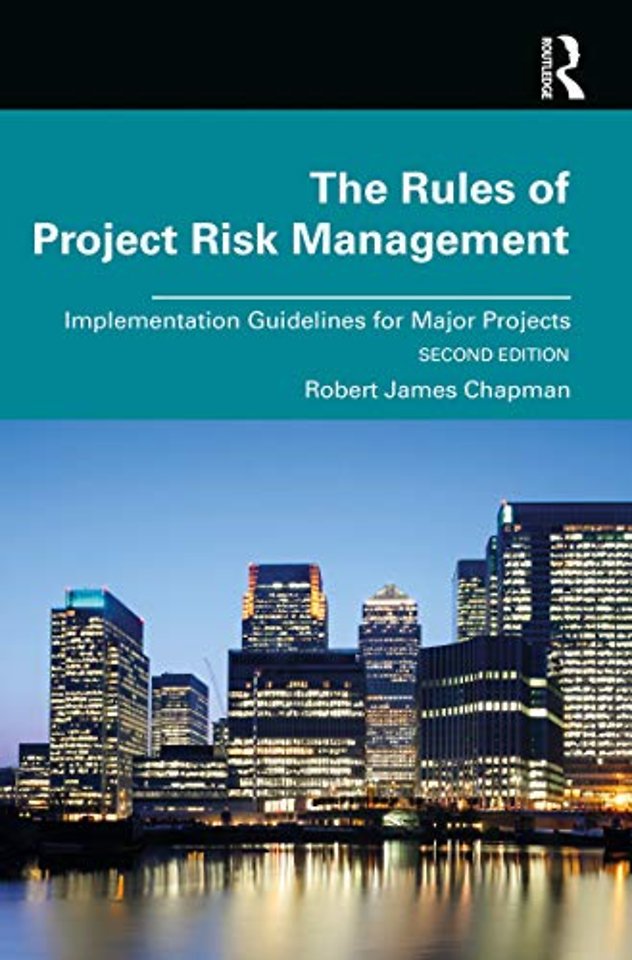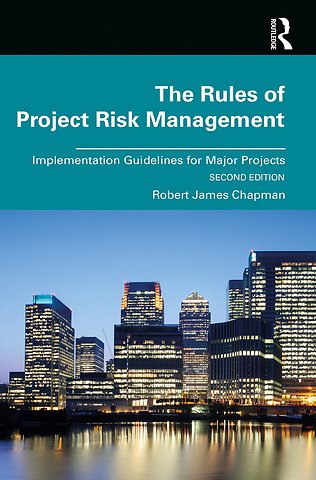Rules of Project Risk Management
Implementation Guidelines for Major Projects
Gebonden Engels 2019 2e druk 9780367209322Samenvatting
The Rules of Project Risk Management, 2nd Edition, provides practical experience-based guidance to support the delivery of effective project risk management. While the discipline is recognised as a major contributor to the successful outcome of projects, its implementation is far from straightforward. Successful delivery requires an in-depth understanding of the "ingredients" of effective risk management practices which impact project performance. The book’s value is derived from the description of these ingredients in a manner which will support their practical implementation.
The author describes a series of guidelines (labelled "rules") to support the practical application of project risk management to positively influence project outcomes. The rules are supported by mini case studies of both successful and unsuccessful projects to bring to life the ramifications of effective and poor risk management respectively, and are assembled under seven headings of environment, external stakeholders, organisation and culture, leadership and governance, internal stakeholders, risk resources and system. This second edition contains a new glossary of terms and an overview of the risk management process to enable those new to the subject to understand the core risk management activities. It also contains six more individual guidelines and ten more case studies to support practitioners, researchers and academics alike to gain an even greater appreciation of the drivers of successful project risk management.
Enabling the reader to "get inside" risk management to gain an appreciation of the individual components and "how the engine works", this book is essential reading for project and risk management professionals. While the guidelines are described individually so specific subjects can be examined in detail, they must be considered together, for like a car, specialist carburettors, fuel injection or high-octane fuel on their own do not support improved performance. The guidelines can be considered as the elements that should be taken into account when compiling a risk maturity model to drive incremental improvement in risk management practices.
Specificaties
Lezersrecensies
Inhoudsopgave
Endorsements for the first edition
Endorsements for the second edition
List of Figures
List of Tables
List of Mini Case Studies
About the author
Foreword
Preface to the second edition
Acknowledgements
Audience
How to read this book
Glossary
Section 1 LAYOUT OF THE BOOK
Section 2 OVERVIEW OF PROJECT RISK MANAGEMENT
Section 3 ENVIRONMENT: The uncertainty characteristics of a project are the product of their origin and particularly their context,
Section 4 EXTERNAL PROJECT STAKEHOLDERS: Project success requires comprehension of the potential impact of external stakeholders on project uncertainty, Contractor participation in risk management is driven by contract obligations,
Section 5 ORGANISATION and CULTURE: Risk management aspirations need to be rooted in reality, The risk profile of a project will be directly influenced by the procurement process,
Section 6 LEADERSHIP and GOVERNANCE: Awareness of the need to manage risk, Mandate for the implementation of risk management, Creation and communication of accountabilities and responsibilities, Internal control and risk assurance processes, Effective decision making is dependent on risk management, Senior management commitment to risk management needs to be visible,
Section 7 INTERNAL STAKEHOLDERS: Risk management must include an assessment of internal stakeholders, Involve internal stakeholders in evaluation of the risks to the business case, Inculcating risk is improved by convincing the sceptics,
Section 8 RISK RESOURCES: Risk team selection will directly influence risk management effectiveness, The budget will dictate the level of risk management support,
Section 9 SYSTEMS: A risk management framework must establish a firm foundation, Commitment commences with a risk policy, Project outcomes are enriched by implementing lessons learned., Risk analysis needs to recognise the existence of optimism bias., The workshop ‘circus’ is avoided by recognising behaviour types., Project success and particularly risk management is dependent on proactive behaviour, Risk descriptions are improved by adopting a metalanguage, Risk database integration is improved when scheduled, Risk model results are improved by sense checking, Risk management is enhanced through integration, Assessing the risk profile of a project must take account of its degree of complexity., Risk management must include examination of opportunities as well as threats,
APPENDIX A: EFQM Excellence Model,
APPENDIX B: Systems thinking,
APPENDIX C: Causes of project failure,
APPENDIX D: Observations about the Standard,
APPENDIX E: Drivers for project success,
APPENDIX F: Mitchel, Bradley and Wood’s stakeholder typology,
APPENDIX G: The power – predictability matrix,
APPENDIX H: Maturity Model Descriptions,
APPENDIX I: Recording Lessons Learned,
APPENDIX J: Procurement Process,
APPENDIX K: Cybersecurity CMM,
Index
Anderen die dit boek kochten, kochten ook
Rubrieken
- advisering
- algemeen management
- coaching en trainen
- communicatie en media
- economie
- financieel management
- inkoop en logistiek
- internet en social media
- it-management / ict
- juridisch
- leiderschap
- marketing
- mens en maatschappij
- non-profit
- ondernemen
- organisatiekunde
- personal finance
- personeelsmanagement
- persoonlijke effectiviteit
- projectmanagement
- psychologie
- reclame en verkoop
- strategisch management
- verandermanagement
- werk en loopbaan







